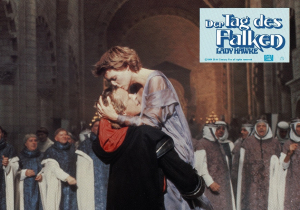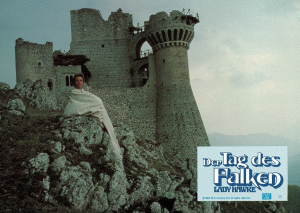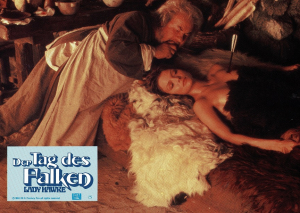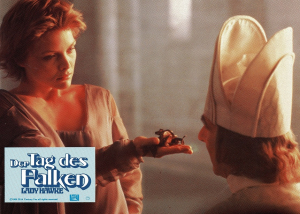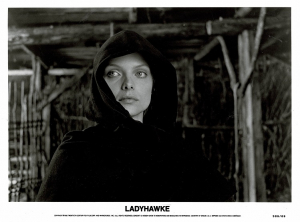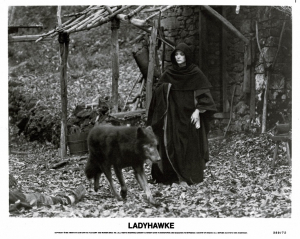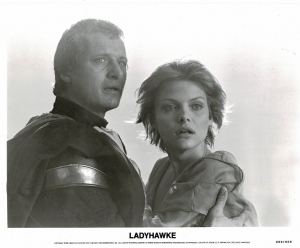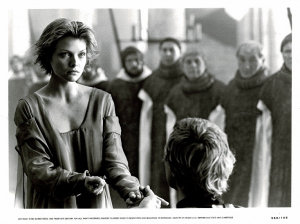LADYHAWKE
Production Information-
About the Story…
“Etienne Navarre and Isabeau of Anjou. Their love was strong tr-than anything that could stand-in its way. Until they we re betrayed… and the black powers of hell spat up a terrible curse.
“She was t o be a hawk by day and he–a wolf by night. Only for a split second, at sunrise and sunset, could they almost touch…”
More than seven centuries ago, .in an age of enchantment and adventure, the dungeons of Aquila were the most notorious in the world.
Only one man is said to have escaped their depths…. Phillipe Gaston, “Phillipe the Mouse,” occupation cutpurse. Wriggling through a narrow drain, then swimming the .catacombs, the young thief emerged beyond the city’s walls, grateful to God for the wonder of freedom.
More wondrous still was aligure which crossed his horizon… a knight, in black armor, astride a’prancing black stallion. Perched on the rider’s outstretched arm was -a glorious hawk with glinting green eyes.
By nightfall, Philippe would know the pair in a new an bird frightening way… when the became the bewitched maiden, Isabeau, and the nobleman’s form changed to that of a prowling wolf.
“Ladyhawke,” A Lauren Shuler Production and A Richard Donner Film for Warner Bros. release, stars Matthew Broderick,Rutger Hauer and Michelle Pfeiffer. Leo McKern, John Wood and Ken Hutchison co-star in the legendary adventure, directed by Donner and produced by Lauren Shuler and Donner from the screenplay by Edward Khmara, Michael Thomas and Tom Mankiewicz.
Harvey Bernhard is executive producer. Music composed and conducted by Andrew Powell.
The story of the lovers, fated to be “always together, eternally apart,” has its Origins in the 13th century. It has since been retold in countless forms, from paintings on the walls of the Mausturm Castle in the Rhine Valley to the “loupgarou” legend of France’s Auvergne Forest to the fables of the beloved Spanish storyteller, Rodriguez de la Fuente.
For his version, director Donner went as far back as he could into medieval mythology, striving in cinematic terms for the “blend of mysticism and reality” with which the minstrels’of the Dark Ages enlightened their audiences.
“What attracted me to ‘Ladyhawke’ is that it’s an impossible love story which is ultimately resolved,” says Donner. “It’s adventurous, outrageously romantic and pure escapism, which I prefer to films which set out to show how dull everyday life is… and generally succeed.”
As in the French… and other versions… of the myth, the spell is cast by a corrupt and powerful churchman. Portrayed by John Wood, who starred on Broadway in “Death Trap” and “Amadeus,” the Bishop of Aquila is not a man given to Christian mercy.
Spurned in his passion for Isabeau, determined that if he cannot possess her, no man will, he strikes “an unholy bargain with the Evil One
Now, two years later, be moves through the vast stone Cathedral of Aquila like a wraith, comforted only by the cries that drift, like smoke, from his dungeons below.
One of those cells is the temporary residence of Phillipe Gaston, whose size has earned him the nickname “the mouse” and whose crimes have earned him a sentence of death.
Unlike the Bishop, “the mouse” has a cordial relationship with his Maker. As he slithers through the sewers, he swears that if God will only guide the way, he will never steal another purse. If not, there will be no hard feelings,
Phillipe is played by Matthew Broderick, the video wizard of “WarGames,” who starred and won a Tony Award on Broadway in Neil Simon’s “Brighton Beach Memoirs.” That script also called for witty asides.
“But ‘Ladyhawke’ is different,” Broderick points out. “In ‘Brighton Beach,’ I turned to the audience, almost as a nervous habit. And since the audience changed every night, so did our ‘conversations.’
“In this story, I’m a bit of a con artist, reasoning with myself by talking to God. I know that the Bishop’s troops have orders to kill me on sight, if only to protect the prison’s perfect record.., that no one is released, except to the hangman.
“I also know that I have little chance of getting into heaven. But it can’t hurt to try. And if I’m going to the other place, perhaps I can persuade the Almighty… in his
infinite mercy… to postpone the trip.” .
The knight, Navarre, cares- little that his traveling companion is on speaking terms with God-. There are other reasons why the thief seams heaven-sent.
For two years, Navarre has sought a way to enter Aquila, catch the Bishop unaware and take revenge. If a “mouse” can get out of the labyrinth beneath the city, a “mouse” can get back in.
Phillipe would undertake the mission, he assures – Navarre, were he not a common criminal, unworthy of the honor.
On the other hand, he admits, as a sword whistles past his head and cleaves a nearby tree, perhaps his answer was too hasty.
The journey to Aquila takes the trio–knight, thief and hawk–across an ever-changing terrain, from lowland marshes to rolling meadows of winter wheat to glacial mountain passes.
The only constant is danger as they penetrate deeper into the Bishop’s domain.
The courtyard of a friendly pub becomes a place .of – ambush.., a peasant hovel hides a man-and-wife who augment their meager earnings by butchering travelers.., a forest floor is set with traps by a wolf hunter who matches his prey in cunning and appearance.
But it is an aimless arrow, shot by one of the Bishop’s bowmen, which threatens to end the quest. The circling hawk shrieks and plummets to earth. Phillipe is sent to bring the bird to the one man whose healing arts can save her.
He is brother Imperius, the drunk, disheveled friar– and sole occupant–of a ruined abbey atop a craggy Mountain peak. It was he who betrayed the lovers to the Bishop,- Now he will use a magic which extends beyond medicine to make
amends. If only Navarre and Isabeau will listen… he has found a moment in time when night and day are one and evil consumes itself.
About the Production…
In completing the cast of “Ladyhawke,” Shuler, Donner and Bernhard took an international approach.
The anguished knight is played by Rutger Hauer, the celebrated Dutch actor whose own taste for adventure led him to become a merchant seaman (at age 15), then an Alpine mountain climber before he found his calling in films like “Soldier of Orange” and “Blade Runner.”
His transfigured love is Michelle Pfeiffer, who came to stardom as thesullen, seductive status symbol sought by Al Pacino in “Scarface.”
Australian-born Leo McKern, whose career has ranged from memborable film roles (“A Man For All Seasons,” “Ryan’s Daughter,” the Beatles’ nemesis in “Help!”) to the heralded BBC series, “Rumpole of the Bailey,” plays the contrite Father Imperius. Britain’s Ken Hutchison (“Gandhi,” “Masada,” “Wuthering Heights”), is the relentless Captain of the Guards.
Their destination was Italy where “Ladyhawke” was filmed. Why Italy, Donner was asked.
“We needed crumbling -castles and medieval ruins,” he explained. “And there seem to be more of them, in more suitable condition, in Italy than anywhere else.”
The most critical set was the walled city ofAquila with its ramparts, cobbled streets, thickset stone houses, markets, an encircling moat, a palace and a majestic cathedral
While several medieval “restorations” were proposed,
Donner turned them down as “too new…- too touristy… the Dark Ages at seen through the eyes of a 20th century vacationer.”
It was at this point that the filmmakers became aware of the castles of the late Luchino Visconti. The Italian _director of “The Leopard” and “Death in Venice” traced his ancestrynback to Emperor Charlemagne, who ruled the Italian peninsula
(and much of western Europe) during the 8th century, Among his family’s holdings were three castles in the northern Apennines mountains, near Parma, all of which had been restored to their 13th century splendor.
None of the three was a walled city. But each provided some element–a winding street of narrow steps, a market- square, a bastion–which fit together, like the pieces of a puzzle, to form Aquila.
Each also had its own tale to tell. Soncino Castle, 60 milesnortheast of Parma, was the prize over whidh the Milanese Sforzas and the Republic of Venice fought a continuing series of bloody battles from 1179 until Napoleon stepped in–and made peace–some 600 years later.
Torrechiara, a hilltop stronghold to the west, once belonged to a legendary lothario, Signor Pier Maria Rossi, who .dedicated it to his mistress, Chiara, then kidnapped another beauty, Bianca Pelligrini, And held her prisoner there in a bedroom of solid gold furnishings. When both her family and the relatives of the jilted Chiara sought revenge, Signor Rossi could thank his foresight in having built a love nest on the grounds of an impregnable fortress.
The third site, Castle Arquato, boasts no such romantic legend. Instead, its mystery centers on the awesome engineering feat–for medieval architects–of constructing a “skyscraper” fortress, some eight stories high.
For the hilltop abbey of Brother Imperius, the film- makers traveled from the Apennines mountains to the Gran Sasso range and back another five centuries in time. Rocca Calascio is a. castle out of the Dark Ages, perched 7,000 feet above sea level, overlooking the Adriatic. That proximity provided the basis for a brief visit by King Richard the Lion-Hearted when his vessel was captured, en route home from the Crusades, and he was taken to the castle’s dungeons. (Rocca Calascio was already some 400-years-old at the time).
Since it is one of Italy’s national treasures, permission had to be granted by the Department of Fine Arts in L’Aquila, Abruzzo, not only to film in its ruins but to renovate them up to medieval standards.
During several weeks of painstaking effort, retaining walls were rebuilt, passageways unblocked, an eight-level
garden rejuvenated and vast stone chambers decorated to the
taste of A dissolute monk by Production Designer Wolf Kroeger. In this transformation, safety was as crucial as aesthetics. While the script called for a rotting drawbridge, the one at Rocca Calascio was so rickety as to pose a threat to actors, horses and technicians. And though the sheer drop from the castle’s turret to the jagged valley below provided a spectacular sequence–the metamorphosis of Isabeau to her winged-self in midair–there was always the danger that an unlikely crew member would follow the same flight path.
The promontory which made Rocca Calascio so scenic posed other problems, as well. How would cameras, sound equipment, lights, catering trucks and the other paraphernalia of filmmaking be taken up the cliff side? The answer was to build a funicular railway from the tent city at the mountain’s base to the location above.
From the highest point in the Gran Sasso mountains, the film crew descended into the tunnels that run beneath Rome. First used by early Christians as escape routes and underground churches, some became the basis for the city’s modern subway system. Others were converted to mushroom farms.
Now, by flooding a section of the caves and catacombs below the Via Salaria, Donner converted them to the sewers of Aquila through which Gaston swims to freedom.
In all, some 13 sites of historic significance were adapted to “Ladyhawke,” from an Etruscan Bridge, circa 600 B.C., across the Fiora River (generally acknowledged as the oldest span in western Europe) to the Campo Imperatore, a popular ski resort which briefly served as Mussolini’s headquarters in the waning days of World War II.
Among the busiest participants, as the film crew crisscrossed the Italian peninsula, were animal trainer Ron Oxley and his staff. In addition to a flock of well- schooled hawks, Oxley imported four Siberian wolves from California to Italy–to portray Hauer’s lupine alter ego– rather than work with the domestic variety.
“The Siberian breed is not only larger and fiercer, but surprisingly more trainable than the European wolf, found in most zoos,” he explains.
Adds Cheryl Shawver, Oxley’s assistant who raised the wolves, Kollchek, Levi, Akeela and Sasha, from birth: “Wolves look so much like dogs that it’s easy to be deceived.
“Dogs do tricks to please. Wolves travel in packs and perform only according to their precise ‘pecking order’ in the pack. If you confuse them, even in play, you are apt to have problems with an animal which stands more than six feet tall on its hind legs and is stronger, pound for pound, than a sumo wrestler.”
Perhaps the most paradoxical element in “Ladyhawke,” admits Donner, was his decision–with costumer Nana Cecchi –to clothe his hero entirely in black and his villain in white.
To cinematographer Vittorio’Storaro, a two-time Academy Award winner (for “Apocalypse Now” and “Reds”), the “forhidden white” of the Bishop’s vestments symbolizes his hypocrisy.
“He is a catabolic—destructive force.., bathed in an image of purity… to hide the abomination within,” says Storaro.
As for Navarre’s black armor, leather and cape, Richard Donner has a simpler explanation.
“It’s accurate to its time,” he points out. “A knight on a quest would hardly wear a color which would show dirt and bloodstains.., or make him a target to his enemy.”
About the Cast…
“I have not seen what I have seen, and I do not believe what I believe. These are magical, unexplainable matters, and I beg you not to make me part of them.”
With those wily words of self-protection, Phillip? Gaston, pickpocket extraordinaire, tries to escape the strange events swirling about him–not to mention certain doom. But, unrepentant rogue that he is, he cannot long resist the lure of high
stakes, nor the call of high adventure.
By the sate token MATTHEW BRODERICK, who plays him, could not resist his own pied piper.
Born in .New York City to the late actor James Broderick and his playwright-director wife Patsy, young Broderick spenthis childhood planning to be a fireman, a baseball player or a veterinarian, in that order. (“There was never any pressure on
me to become an actor,” he recalls.)
Just before graduating from New York’s Walden School, however, he co-starred with his father off-off Broadway in Horton Foote’s”Valentine’s Day,” and decided then and there to carve out an acting career for himself.
Instead of going to college, he studied his craft with noted drama coach Uta Hagen and voice coach Robert Leonard, and spent summers with his father on the “strawhat circuit.”
After his bow in a guest-starring role on television’s “Lou Grant” series, Broderick landed a six-month starring role in Harvey Fierstein’s off-Broadway hit, “Torch Song Trilogy.” His performance as David won both the Outer Circle Critics’ and Villager Awards, and brought splendid reviews. (Newsweek called him “witty, original and touching”… Variety predicted “a bright future.”)
Catching the eye of playwright Neil Simon, Broderick was cast as Marsha Mason’s teenage son in “Max Dugan Returns.”
It was with his second screen role, however, that he gained worldwide renown. As David Lightman, a restless high school student with a flair for computers, he brought the world to the brink of nuclear disaster in “WarGames.”
The film was a smash hit.
Meanwhile, Broderick was enjoying a reunion with Neil Simon as the star of “Brighton Beach Memoirs,” which opened first in Los Angeles, then moved to Broadway. There it brought him the coveted Tony Award.
Broderick will next appear in the play’s sequel, “Biloxi Blues,” also set to open in Los Angeles. Beneath his commanding presence as ex-captain of the guards, the loneliness of Etienne of Navarre’s long-blazing love has left only the banked fires of Vengeance.
Described as “an awesome man with a dangerous distance in his cold blue eyes,” he is portrayed in all his pain and power by RUTGER HAUER, Holland’s top film star.
Perhaps best known for his role as Harrison Ford’s nemesis in “Blade Runner” and his princely World War II hero in the Oscar-nominated “Soldier of Orange,” Hauer comes by his calling naturally. Both his parents were actors.
Born in the Dutch city of Breukelen (from which the New York borough of Brooklyn draws its name), he was a free- spirited youngster who refused to settle down to his studies.
At 15, following in the footsteps of his great grandfather–the captain of a tea schooner–he lied about his age and signed aboard a freighter as a merchant seaman.
The voyage was cut short when it was discovered that he was color-blind.
At 16 he took the advice of a teacher who suggested he needed self-discipline, and joined the army. Skilled in both combat training and athletics, he was offered an officer’s commission, turned it down, and fled to the Alps for a brief stint as a mountain climber. Returning to Amsterdam, Hauer graduated from drama school at 23,- joined a newly-formed repertory troupe, and spent five years bringing amateur experimental theatre to the farmers of Northern Holland. His favorite–John Steinbeck’s “Of Mice and Men,” in which he played Lenny.
Moving into films in 1973, Hauer made his screen bow in “Turkish Delight,” Oscar-nominated as Best Foreign Language Film. In a career noted for its diversity of . roles, he has since played a terrorist opposite Sylvester Stallone in “Nighthawks” and Coco Chanel’s lover in “Chanel Solitaire.”_
Described by young Phillipe as “a lady like fine porcelain, with glowing jade eyes and the dulcet tones of an angel,” MICHELLE PFEIFFER‘s Isabeau of Anjou is a bird of a different feather from anything she has played before,
Most recently seen as the cocaine-wrapped wife of Cuban crime czar Al Pacino in “Scarface,” she has also appeared as the flamboyant Pink Lady, leader of an outlaw high school sorority in “Grease 2,” and As a conscientious carhop in “Hollywood Knights.” Other roles include the . rich teenager who marries the poor Jewish boy from the Bronx in “Falling in Love Again,” and the sheltered Cordelia Farrington III in “Charlie Chan and the Curse of the Dragon Queen.”
Born into a close-knit family in California’s Orange County, Pfeiffer first studied theatre in high school, then clerked in a local supermarket to pay for acting lessonsin neighboring Los Angeles.
After a friend entered her in a beauty pageant, Pfeiffer attracted her first agent and landed her first role–as “The Bombshell” in a short-lived television series,”Delta House.” Since then, alternating with films, she has co-starred in the television movies “Callie and Son,” “The Solitary Man,” “The Children That Nobody Wanted” and “Splendor in the Grass.”
Pfeiffer has also tried her hand at live theatre, appearing in a Los Angeles Equity waiver production of “Playground in the Fall.”
As the defrocked priest, Imperius, LEO McKERN gives new meaning to the adage “in vino- veritas” (“in wine, truth”).
Lurching down from his reclusive mountaintop abbey–where he has nursed his hangovers along with his guilts–he not only drops a few pearls of wisdom to the young lovers as to how they might break their sinister spell, but also spills the beans about who did it to them.
Lovable rogues are a McKern mainstay. A distinguished veteran of the British theatre and motion pictures, with more than 200 plays and two dozen films to his credit., he began his career with London’s Old Vic after emigrating from his native Australia in 1946.
Most recently seen on screen as the dour doctor in “The French Lieutenant’s Woman” and the boozy old ship’s cook who survives with Brooke Shields and Christopher Atkins in “The Blue Lagoon,” McKern has also portrayed Cromwell in “A Man For All Seasons,” Ryan in.”R an’s Daughter” and Bugenhagen in “The Omen.”
His all-time favorite? An unforgettable “Peer Gynt”for the Old Vic in 1962.
Perhaps his best _known recent role is “Rumpole of the Bailey,” winner of virtually every award for which British television is eligible.
The conniving, demonic Bishop of Aquila–who masks his cold-eyed hatred behind churchly robes-and-rites–is portrayed by another longtime British theatrical stalwart, JOHN WOOD.
An associate artist with the Royal Shakespeare Company, and a regular performer at the National Theatre, Wood is also a three-time Tony nominee for this distinguished work in Broadway’s “Rosencrantz and Guildenstern,” “Sherlock Holmes” and “Travesties” (which brought him the award as well). His motion picture bow came recently–as the computer genius Who outfoxed Matthew Broderick in “WarGames.”
Born just outside London, Wood was a law student at Oxford before he “slid gently into acting,” which he found “much more fun.”
Among his noted recent stage credits are the original London production of “Death Trap,” in which he starred as the dramatist who literally murders his writer’s block, and the Broadway and Los Angeles productions of “Amadeus,” in which he played Mozart’s mortal enemy, Salieri.
When, as “Ladyhawke’s” benighted bishop, Wood warns that “great storms announce themselves with a .simple breeze,” he is talking to his head henchman.–Guard Captain Marquet, played by KEN HUTCHISON.
A tall, lean and saturnine Englishman, the classically trained actor has concentrated on television until now.
Perhaps best known as the: tormented romantic Heathcliff in the BBC’s popular miniseries, “Wuthering Heights,” Hutchison also co-starred in the highly-regarded, top-rated “Masada.”
Film audiences have seen him in Richard Attenborough’s “Gandhi.”
About the Filmmakers…
That “Ladyhawke” holds a special attraction for
Director/Producer RICHARD DONNER comes as no surprise.
Critically acclaimed for bringing “verisimilitude to the unreal” in films like “Superman, the Movie” and “The Omen,” Donner believes that movies should take people “into landscapes, emotional as well as visual, where they haven’t been before.”
That conviction has been shaped during 30 years in films and television, dating back to the “golden age” of live video drama where he learned his craft with such contemporaries as Sidney Lumet, John Frankenheimer and Arthur Penn.
Born to a furniture maker in Manhattan, Donner studied both business and theatre arts at New York University. His first ambition was to be an actor But after a succession of “five-line parts” off- Broadway, an encounter with director Martin Ritt during a TV
version of W. Somerset Maugham’s “Of Human Bondage” changed his plans. Ritt insisted that Donner’s future lay not in acting but behind the camera, and confirmed the judgment with a job as this assistant.
Transferring his new career to California in 1958, Donner directed commercials, industrial films and some highly-successful documentaries Then came “Wanted: Dead or Alive,” the hit series in which he directed newcomer Steve McQueen.
The hugely popular “Kojak” followed his directing chores on “The Twilight Zone” and “Bronk” series. He also directed a number of well-received specials such as “Portrait of a Teenage:. Alcoholic.” Virtually every time Donner directed a pilot, it became a series.
Since his entry into motion pictures with the macabre hit, “The Omen,” Donner has directed the blockbuster, “Superman, the Movie,” the warmly human “Inside Moves” and the satiric comedy, “The Toy.”
Producer LAUREN SHULER, who calls “Ladyhawke” her “five-year pet,” is an ex-film student from Cleveland, Ohio, who tackled Hollywood on her own just after graduating from Boston University.
Hired first as an assistant film editor by a company doing medical and educational films, she laid siege to NBC in Burbank, until she finally landed the job she wanted– cameraperson.
After shooting local programs there, she moved on to Metromedia to film everything from rock concerts to comedy series and television movies.
Still proud of being the first woman voted into the Hollywood Cameraman’s Union (I.A.T.S.E. Local 659), she soon rose to associate-producer ranks with such major television fare as ABC’s “Wide World of Entertainment.” She then produced NBC’s widely-hailed “Amateur Night at the Dixie Bar and Grill,” in which her offbeat casting of Tanya Tucker, Dennis Quaid, Henry Gibson and Candy Clark won special praise.
Shuler entered the producer ranks with “Mr. Mom,” a hugely-successful comedy she not only developed with writer ‘John Hughes, but also packaged with Michael Keaton.
It was she who initiated and nurtured the making of “Ladyhawke.” Shuler is currently producing “St. Elmo’s Fire” for Columbia, with a star cast that includes Emilio Estevez, Rob Lowe, Andrew McCarthy, Demi Moore, Judd Nelson, Ally Sheedy and Marc Winningham.
Reuniting with Richard Donner for the first time since “The Omen,” filmmaker HARVEY BERNHARD serves as Executive Producer on “Ladyhawke.”
Born in Seattle and educated at Stanford University– where he majored in economics and captained the football team–Bernhard began his filmmaking career producing television series with partner Sandy Howard.
Moving on to Metromedia, Bernhard joined with David Wolper and spent ten years in charge of production for more than 1,000 documentary Specials. With Wolper; he was also involved in the production of the motion pictures “The Devil’s Brigade” and “If It’s Tuesday, It Must Be Belgium.”
Bernhard’s first solo venture was “The Mack,” which starred Richard Pryor. A low-budget crime-thriller which scored high at the box office, it was followed by “The Omen,” which Bernhard based on his own screen treatment about the devil’s son turned loose on an unsuspecting world.
Its success sired two sequels–“Omen II” and “The Final Conflict.” All three are among the industry’s hundred highest-grossing films.
Dubbed “Italy’s gift to films, a modern-day Michel- angelo,” Director of ph otography VITTORIO STORARO has won Academy Awards for his luminous work on “Apocalypse Now” and “Reds,” as well as 12 other international honors for “Last Tango in Paris,” “Identikit,” “1900,” “Agatha” and “Luna.”
Born in Rome and educated at that city’s photographic institute, the Duca D’Aosta, he won admission to the prestigious Centro Sperimentale–Italy’s highest state school of cinema arts–where he earned a degree in cinematography.
Shortly after graduating, he was discovered by famed Italian directors Bernardo Bertolucci and Franco Rossi, and his career took off.
Storaro has most recently worked with Francis Coppola on “One From the Heart” and Tony Palmer on “Richard Wagner.” “Ladyhawke” is a first-time collaboration for Screen-writers EDWARD KHMARA, MICHAEL THOMAS and TOM MANKIEWICZ.
It is also the motion picture debut for Khmara, a young American writer. Thomas, an Australian writer living in London, co-wrote “The Hunger,” an English film released in the U.S. in 1982.
The credits for Mankiewicz go back to 1971, when he co-wrote the James Bond film, “Diamonds Are Forever.” After two more Bond screenplays–“Live and Let Die” and “The Man with the Golden Gun”–he branched out with “The Cassandra
Crossing” and “The Eagle Has Landed.” His television credits include the pilot for “Hart to Hart” and the series “Gavilan.”
Warner Bros. and Twentieth Century Fox present Matthew Broderick, Rutger Hauer and Michelle Pfeiffer in A Lauren Shuler Production of A Richard Donner Film, “Ladyhawke,” starring Leo McKern and John Wood. Directed by Richard Donner, it is produced by Richard Donner and Lauren Shuler from a screenplay by Edward Khmara and – Michael Thomas and Tom Mankiewicz, and a story by Edward Khmara. Harvey Bernhard served as the executive producer and Tom Mankiewicz served as consultant. Vittorio Storaro was the director of photography. The music was composed and conducted by Andrew Powell. Released by Warner Bros.,
A Warner Communications Company. [/vc_column_text]
